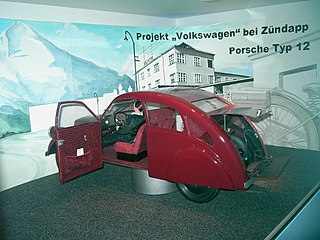
The Volkswagen Beetle—officially the Volkswagen Type 1, informally in German der Käfer, in parts of the English-speaking world the Bug, and known by many other nicknames in other languages—is a two-door, rear-engine economy car, intended for five occupants, that was manufactured and marketed by German automaker Volkswagen (VW) from 1938 until 2003.

The Junkers Jumo 004 was the world's first production turbojet engine in operational use, and the first successful axial compressor turbojet engine. Some 8,000 units were manufactured by Junkers in Germany late in World War II, powering the Messerschmitt Me 262 fighter and the Arado Ar 234 reconnaissance/bomber, along with prototypes, including the Horten Ho 229. Variants and copies of the engine were produced in Eastern Europe and the USSR for several years following the end of WWII.

The BMW 003 is an early axial turbojet engine produced by BMW AG in Germany during World War II. The 003 and the Junkers Jumo 004 were the only German turbojet engines to reach production during World War II.

Front-wheel drive (FWD) is a form of engine and transmission layout used in motor vehicles, where the engine drives the front wheels only. Most modern front-wheel-drive vehicles feature a transverse engine, rather than the conventional longitudinal engine arrangement generally found in rear-wheel-drive and four-wheel drive vehicles.

The Standard Superior was an automobile, produced from 1933 to 1935 by Standard Fahrzeugfabrik of Ludwigsburg, Germany, founded by motorcycle maker Wilhelm Gutbrod and unrelated to the Standard Motor Company of England. These small cars were designed according to the patents by Josef Ganz and featured rear-mounted two-stroke engines.
In automotive engineering, a mid-engine layout describes the placement of an automobile engine in front of the rear-wheel axles, but behind the front axle.

The Triumph Spitfire is a British front-engined, rear-wheel drive, two-passenger convertible sports car introduced at the London Motor Show in 1962 and manufactured between 1962-1980. Styled for Standard-Triumph in 1957 by Italian designer Giovanni Michelotti, the Spitfire was manufactured for the duration of its production at the Standard-Triumph Canley works — and evolved over a series of five production iterations, with a approximately 315,000 manufactured over 18 years.
Sir Alfred Hubert Roy Fedden MBE, FRAeS was an engineer who designed most of Bristol Engine Company's successful piston aircraft engine designs.

The Emergency Fighter Program was the program that resulted from a decision taken on July 3, 1944 by the Luftwaffe regarding the German aircraft manufacturing companies during the last year of the Third Reich.

Fishtailing is a vehicle handling problem which occurs when the rear wheels lose traction, resulting in oversteer. This can be caused by low friction surfaces. Rear-drive vehicles with sufficient power can induce this loss of traction on any surface, which is called power-oversteer.

Straker-Squire was a British automobile manufacturer based in Bristol, and later Edmonton in North London.

From 1931 to 1939, Daimler-Benz AG produced three cars with rear engine as well as a few prototypes. The production numbers remained quite low for each of these models, especially compared to the production of classical front-engine Mercedes cars.

The Schlörwagen was a prototype aerodynamic rear-engine passenger vehicle developed by Karl Schlör (1911–1997) and presented to the public at the 1939 Berlin Auto Show. It never went into production, and the sole prototype has not survived.

Völkenrode is a quarter (Stadtteil) of Braunschweig, Lower Saxony, Germany. Völkenrode, formerly a municipality on its own and part of the district of Braunschweig, was incorporated into the city of Braunschweig in 1974. Today, it is part of the Stadtbezirk Lehndorf-Watenbüttel.
Luftfahrtforschungsanstalt was a secret German facility for airframe, aeroengine, and aircraft weapons testing during the Second World War. It was Germany's "most advanced and extensive [aviation] research establishment, outside of the existing Erprobungsstelle network of military aviation evaluation facilities, themselves headquartered at Rechlin.
Messerschmitt P.1108 Fernbomber was a design for a jet-propelled bomber developed for the Luftwaffe by Messerschmitt during the last years of Nazi Germany. It was never completed.

The Porsche Type 12 was a German project to develop an "Everyman's automobile" for Zündapp. The Type 12 was designed by Ferdinand Porsche in 1931, and prototypes were built in 1932.
The Cotswold was a turboprop aircraft engine designed by Roy Fedden after the Second World War.
The Fedden Mission was a British scientific mission sent by the Ministry of Aircraft Production to Germany at the end of the Second World War in Europe, to gather technical intelligence about German aircraft and aeroengines. It was named for the Mission's leader, Roy Fedden. It visited Bad Oeynhausen, Bad Eilsen, Völkenrode, Braunschweig, Magdeburg, Oschersleben, Staßfurt, Dessau, Kothen, Nordhausen, Göttingen, Kassel, Eisenach, Frankfurt, Rüsselsheim, Darmstadt, Stuttgart, Esslingen, Reutlingen, Mengen, Lindau, Freising, Munich, Rosenheim, Kochel, Oberammergau, Kolbermoor, Salzburg, Spittal, Villach, and Klagenfurt. This is much less than the fifty-two locations they had intended to visit when the Mission began.

The Alfa Romeo Scarabeo is a concept car engineered by Giuseppe Busso and Orazio Satta Puliga for Alfa Romeo with a body designed by Sergio Sartorelli at Officine Stampaggi Industriali. The car debuted at the Paris Motor Show in 1966.